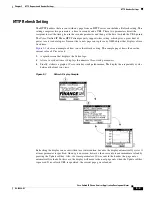
5-8
Cisco Unified IP Phone Services Application Development Notes
OL-18696-01
Chapter 5 HTTP Requests and Header Settings
Accept Header
Note
Beginning with the IP Phone Services SDK 3.3(3), the SDK version number matches the minimum
Cisco Unified Communications Manager software that is required to support it. For example, SDK
version 3.3(4) gets supported only on Cisco Communications Manager version 3.3(4) or later.
Accept Header
The Accept header represents a standard HTTP header that is used to inform web servers about the
content-handling capabilities of the client.
Cisco Unified IP Phones include proprietary content-types to indicate which XML objects are
supported. These proprietary content-types all begin with x-CiscoIPPhone, to indicate
Cisco Unified IP Phone XML objects, followed by a slash “/”, followed by either a specific XML object
or a “*” to indicate all objects.
For example, x-CiscoIPPhone/* indicates that all XML objects defined in the specified version of the
SDK are supported, and x-CiscoIPPhone/Menu specifies that the
<CiscoIPPhoneMenu>
object gets
supported.
As the example illustrates, the name of the XML object can be derived directly from the content-type by
appending the sub-type (the part after the slash) onto “CiscoIPPhone.” The content-type can also include
an optional version to indicate support for a particular SDK version of that object. If a version is not
specified, then the x-CiscoIPPhoneSDKVersion is implied. The syntax of the version number may vary,
but, in general, will be as follows:
<major version>.<minor version>.<maintenance version>
Here are some examples of typical content-types:
x-CiscoIPPhone/*;version=3.3.3
x-CiscoIPPhone/Text
x-CiscoIPPhone/Menu;version=3.3.4
Accessing IP Phone Information
Cisco Unified IP Phones have an embedded web server to provide a programming interface for external
applications and a debugging and management interface for system administrators.
You can access the administrative pages using a standard web browser and pointing to the IP address of
the phone with: /http://<
phoneIP
>/, where
phoneIP
is the IP address of the specific phone.
These device information pages are available in either HTML format, for manual debugging purposes,
or in XML format for automation purposes.
Table 5-1
lists the available URLs and their purpose.
Table 5-1
Device Information URLs
HTML URL
XML URL
Description
/DeviceInformation
/DeviceInformationX
General device information
/NetworkConfiguration
/NetworkConfigurationX
Network configuration information
/EthernetInformation
/EthernetInformationX
Ethernet counters
















































